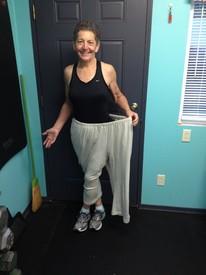Help! How to start a swimming regimen?

atypicalsmith
Posts: 2,742 Member
I went to the Y today, full of determination to add swimming to my current repertoire of exercises to do on a regular basis. YIKES! I was only in the pool for fifteen minutes. I swam for maybe 20 seconds tops and had to stop to catch my breath. Started to swim another 20 seconds or so, and had to stop to catch my breath, except now it was too deep for me to stand. So I flipped on my back and swam back to shallower ground. This sort of set my pace. Swim 20 seconds, stop, catch my breath for 30 seconds. I am (allegedly) NOT out of shape! Yes, I need to lose another 35, but I can do treadmill, outdoor walking, exerbike, and light cardio just fine for an hour or more. There were a few times when I had a personal trainer that I ran out of breath, but not that many times. What is different about swimming? Clearly, I'm out of shape for it, and don't get why people say it's "low impact exercise". My body was killing me after a total of MAYBE five minutes of actual swimming? Help!
0
Replies
-
Swimming uses all your muscles at once, more so than walking, treadmill, even running, etc. I would suggest upping the intensity of the cardio you are doing and consider strength training on non-swimming days. Try some of the "easier" strokes such as side stroke or elementary backstroke. Then keep doing what you're doing, swim as far as you can, rest or switch to an easier stroke, then swim again. You will gradually build up your endurance and ability. I love swimming but I am having difficulty with lap swimming times that suit my schedule.
FYI swimming is "low impact" because it does not place force or stress on your joints. That doesn't mean it's "low intensity."
PS You also can consider looking into an adult swimming class at the Y that focuses on stroke improvement and learning all 4 basic strokes. Swimming "efficiently" is easier and being able to rotate strokes gives various muscles, and lungs, a break.0 -
I recently started swimming again after not being in the pool much for a number of years. That's pretty much exactly where I was at in June. Yesterday I did my first "lap" where I swam there & back without stopping. But when I started I would stop once or twice a length, every few seconds, and would wait about 5min before attempting again catching my breath. I think it's partially the breathing, it taxes your lungs because you need a breath to last you longer than on land. A funny thing about water - muscle sinks and fat floats, so sometimes being more fit makes you work harder to stay afloat.0
-
To emphasize @lorrpb's point : technique. Swim is SO SO SO technique based. Have pretty strokes, you can glide through the water effortlessly. Drop your hips (that's the biggest one), kick from your knees, splash your body instead of rolling and streamlining--you are making it SO much harder for yourself.
If you have the option to take a private lesson, I bet it would help a lot. Otherwise, you might want to check out some swim drill videos on YouTube. You could even do the think weightlifting people do--have someone film you swimming, then upload the video to the Swimmers group here or the Swimming subreddit and ask for some pointers.
In the meantime, you could try alternating swimming laps with kicking-with-a-kickboard (keeps your head up; easier to breathe) and pool running with a flotation belt (an activity that is as hard as you make it--it can be nothing at all, or it can be a marathon-quality workout.)
After that, here are a couple programs to consider:
0 to 700 (yards/meters)
700 to 1650 (that's a swim mile)0 -
I recently started swimming again after not being in the pool much for a number of years. That's pretty much exactly where I was at in June. Yesterday I did my first "lap" where I swam there & back without stopping. But when I started I would stop once or twice a length, every few seconds, and would wait about 5min before attempting again catching my breath. I think it's partially the breathing, it taxes your lungs because you need a breath to last you longer than on land. A funny thing about water - muscle sinks and fat floats, so sometimes being more fit makes you work harder to stay afloat.
It's so good to know I'm not the only one! Thanks so much for the confirmation that I'm not completely nuts!0 -
cheshirecatastrophe wrote: »To emphasize @lorrpb's point : technique. Swim is SO SO SO technique based. Have pretty strokes, you can glide through the water effortlessly. Drop your hips (that's the biggest one), kick from your knees, splash your body instead of rolling and streamlining--you are making it SO much harder for yourself.
If you have the option to take a private lesson, I bet it would help a lot. Otherwise, you might want to check out some swim drill videos on YouTube. You could even do the think weightlifting people do--have someone film you swimming, then upload the video to the Swimmers group here or the Swimming subreddit and ask for some pointers.
In the meantime, you could try alternating swimming laps with kicking-with-a-kickboard (keeps your head up; easier to breathe) and pool running with a flotation belt (an activity that is as hard as you make it--it can be nothing at all, or it can be a marathon-quality workout.)
After that, here are a couple programs to consider:
0 to 700 (yards/meters)
700 to 1650 (that's a swim mile)
Thanks! I'll check to see if the Y has adult classes. My form isn't too bad (in my opinion, hah!) as I am kicking from my knees and can actually stay afloat, but other than that, I probably need a LOT of help! Thanks so much for your suggestions about youtube and other programs.0 -
atypicalsmith wrote: »cheshirecatastrophe wrote: »To emphasize @lorrpb's point : technique. Swim is SO SO SO technique based. Have pretty strokes, you can glide through the water effortlessly. Drop your hips (that's the biggest one), kick from your knees, splash your body instead of rolling and streamlining--you are making it SO much harder for yourself.
If you have the option to take a private lesson, I bet it would help a lot. Otherwise, you might want to check out some swim drill videos on YouTube. You could even do the think weightlifting people do--have someone film you swimming, then upload the video to the Swimmers group here or the Swimming subreddit and ask for some pointers.
In the meantime, you could try alternating swimming laps with kicking-with-a-kickboard (keeps your head up; easier to breathe) and pool running with a flotation belt (an activity that is as hard as you make it--it can be nothing at all, or it can be a marathon-quality workout.)
After that, here are a couple programs to consider:
0 to 700 (yards/meters)
700 to 1650 (that's a swim mile)
Thanks! I'll check to see if the Y has adult classes. My form isn't too bad (in my opinion, hah!) as I am kicking from my knees and can actually stay afloat, but other than that, I probably need a LOT of help! Thanks so much for your suggestions about youtube and other programs.
Ah, nope! You want your hips on top of the water, your legs *mostly* straight (knees not locked, but not bending a lot), toes pointed, and kick with your hips and quads. Most of the kick happens underwater; it's not a splashy kick Sorry I wasn't clear!
Sorry I wasn't clear!
Here's a useful example video.0 -
Yes - all about technique - you need to practice blowing out air underwater. If you hold your breath and then try to breathe out/in when you lift your head, you'll very quickly run out of puff. Also, the comment about kicking from the hips, not the knees, is spot on. Kicking too hard is not the most efficient way to swim - try some drills with a pull-buoy between your legs. This keeps your legs afloat and you just use your arms. If your kick is too big, you'll find it easier to breathe. This Aussie group have some great guidance for beginner swimmers: http://www.swimsmooth.com/.0
-
The tips about technique are great advice. I'm definitely not the best swimmer, and don't even keep track of my laps, but I swim for an hour solid most of the time.... I see people who swim harder/faster than me, and then I see those people who seem to "fight" the water. I feel that I'm somewhere in the middle. Needless to say, the ones fighting the water are the ones who swim the least amount of time. I'm exhausted just watching them!
You can do this.... it's easier on me now than when I started, and the hour sometimes moves up to more. 0
0 -
Congratulations on choosing, deciding, and taking action towards swimming as part of your routine in exercise! I am a water professional of over thirty years, swam for sport and fitness, surfed big waves, competed in triathlons and currently a budding ultra endurance cyclist. I still make time to swim three to six days a week to balance out my muscular structure and receive the magical benefits of water.
Swimming is perfect-relaxed technique; watch a porpoise swim and you will know what I mean. Then watch videos on You Tube of Rebecca Soni, Jessica Hardy, Michael Phelps, and Ryan Lochte. Water is 860 times denser than air. You can buy aerodynamics when cycling such as wind tunnel developed bicycles, helmet, and skin suits. But in the water how you shape your body, create propulsion, while relaxing and breathing must be done with your swim suit and your developed kinesthetic sense. It is all you! I recommend two websites:
Total Immersion: http://totalimmersion.net/ I have subscribed to this discipline since Terry Laughlin wrote the book about twenty years ago I have also swam with him at my local pool in Coronado CA. They are international.
Swimsmooth (identifies the six types of swimmers): http://www.swimtypes.com/concept.html (From Australia)
It is imperative to work on technique first and the fitness will come. Relax, learn, and apply all you are instructed because there is nothing worst than repeating incorrect movements you will teach yourself how to swim badly. If choosing an instructor, get one that is currently a good swimmer. Not to reduce the effectiveness of an out of shape-non active swimmer, but a practicing swimmer will apply their current success straight to you. Their motivation is more pure in teaching swimming where the non practicing swimmer's motivation is slanted financially. Be aware in the world of swimming some great swimmers do not appear in shape like a cross fit monster but how they move in the water is purposeful, economical, and most of all effective.
Please feel free to ask me questions.
0 -
atypicalsmith wrote: »I went to the Y today, full of determination to add swimming to my current repertoire of exercises to do on a regular basis. YIKES! I was only in the pool for fifteen minutes. I swam for maybe 20 seconds tops and had to stop to catch my breath. Started to swim another 20 seconds or so, and had to stop to catch my breath, except now it was too deep for me to stand. So I flipped on my back and swam back to shallower ground. This sort of set my pace. Swim 20 seconds, stop, catch my breath for 30 seconds. I am (allegedly) NOT out of shape! Yes, I need to lose another 35, but I can do treadmill, outdoor walking, exerbike, and light cardio just fine for an hour or more. There were a few times when I had a personal trainer that I ran out of breath, but not that many times. What is different about swimming? Clearly, I'm out of shape for it, and don't get why people say it's "low impact exercise". My body was killing me after a total of MAYBE five minutes of actual swimming? Help!
So like other people have said, swimming works all muscles in your body at the same time.
and like anything else, your body has to work at it.
From what it sounds like your doing a great job. Swim one length, and stop, catch your breath and continue until you finish the length. Once your at the other end, wait 3min, and do it again.
Take as many breaks as you need until you get to the end of the length of the pool.
0 -
Get the breathing down first. Stick your face in the water and exhale, turn your head at 90 degrees (half of your mouth will still be in the water probably) and inhale, do this a lot. Part of the issue is that you are using large muscles (back and legs), part of the issue might be trying to hold your breath, it's an instinct you have to try and abandon. I'm not a "good" swimmer by any means, I picked it up so that I could do triathlons, I really enjoy it, I felt the same way you felt, and it was all related to breathing technique. Work at it so that you are exhaling completely when your face is in the water (you don't want to keep air in your lungs too long, it will convert to carbon dioxide, and will not feel good), then breathe in the pocket. I also prefer bilateral breathing, but that is partially due to doing tris.0
-
Thanks EVERYONE for great advice! My Y just finished an adult class and don't know when the next is scheduled but you've provided a wealth of information and links. Thank you so much!0
-
Get the breathing down first. Stick your face in the water and exhale, turn your head at 90 degrees (half of your mouth will still be in the water probably) and inhale, do this a lot. Part of the issue is that you are using large muscles (back and legs), part of the issue might be trying to hold your breath, it's an instinct you have to try and abandon. I'm not a "good" swimmer by any means, I picked it up so that I could do triathlons, I really enjoy it, I felt the same way you felt, and it was all related to breathing technique. Work at it so that you are exhaling completely when your face is in the water (you don't want to keep air in your lungs too long, it will convert to carbon dioxide, and will not feel good), then breathe in the pocket. I also prefer bilateral breathing, but that is partially due to doing tris.
This. Remember, we aren't fish and can't breath underwater so we start at a disadvantage over land exercise. Breathing is important, exhale exhale exhale. I'm a decent swimmer, and if I'm out of training those first few times are tough going. Head down when swimming, don't look forward/up it will bring the rest of your body down into the water making it harder. Slow and steady, speed can come into play later. Find a lane with similar speed swimmers, nothing more frustrating for everyone than picking the wrong lane to swim in. Enjoy the time in the water, don't get discouraged, and have fun.0 -
jchite84 gave some great advice about breathing. If you find you're getting way out of breath and having to stop, then you aren't keeping a steady rhythm--you're probably holding your breath. Don't! Exhale underwater for a few strokes, then turn your head to one side and take a deep breath through your mouth. Exhale through your nose to keep you from swallowing.
It doesn't matter how slow you're going while you work on developing a rhythm, just as long as you're moving. I'm a pretty slow swimmer--but I swim for endurance, usually 90 minutes or so. Get down the breathing, don't worry about how slow you are going, but once you figure out the rhythm, you will find you can swim for longer and further without needing a break.0 -
if you are doing freestyle (front crawl) kicking needs to use the whole leg, its a bit like kicking a football but lying flat in the water. Best form is with your head in the water and moving your head to one side to breathe as your arm is on its way up as this creates a bit of a 'dip' in the water making it easier to breathe, take a breath every 3 arm strokes it will make your body more level in the water and as another poster has said no splashing with the legs
 . Breast stroke can be done with the head out of the water but is more comfy for your shoulders and neck with your head in the water breathing as your arms go toward the body (if all that makes sense).
. Breast stroke can be done with the head out of the water but is more comfy for your shoulders and neck with your head in the water breathing as your arms go toward the body (if all that makes sense).
Just keep at it you will get fitter as you keep going, I used to swim competitively and with form as a lot of people have said it is quite easy to do a lap, practise makes perfect and its a great low impact form of exercise!0 -
If you can afford it, take an adult class to learn the stroke technique. Don't have any ego about it, start at the bottom level and work your way up so you have solid fundamentals with no gaps.
You may be trying to swim too hard/fast as well. Slow down. You didn't start running by sprinting all the time, did you? Breathe every stroke if you have to (alternating sides. Eventually alternate every 3, then every 5 strokes--makes your practice symmetrical).
Avoid just jumping in and swimming. Get in the pool, breathe a little, acclimate to the temperature, then swim thinking of whales, not hummingbirds. You want to be slow and smooth, not frenetic.0 -
I got in the pool again last March, after not swimming seriously since my adolescent swim team days more than 35 years ago. I really appreciate the advice here, in particular the links from @distanthorizons. When I restarted five months ago, it was difficult to tie two lengths together. I found the 0 to 1650 regimen linked above and the workout schedule made the progress just speed by.0
This discussion has been closed.
Categories
- All Categories
- 1.4M Health, Wellness and Goals
- 398.2K Introduce Yourself
- 44.7K Getting Started
- 261K Health and Weight Loss
- 176.4K Food and Nutrition
- 47.7K Recipes
- 233K Fitness and Exercise
- 463 Sleep, Mindfulness and Overall Wellness
- 6.5K Goal: Maintaining Weight
- 8.7K Goal: Gaining Weight and Body Building
- 153.5K Motivation and Support
- 8.4K Challenges
- 1.4K Debate Club
- 96.5K Chit-Chat
- 2.6K Fun and Games
- 4.8K MyFitnessPal Information
- 13 News and Announcements
- 21 MyFitnessPal Academy
- 1.6K Feature Suggestions and Ideas
- 3.2K MyFitnessPal Tech Support Questions












